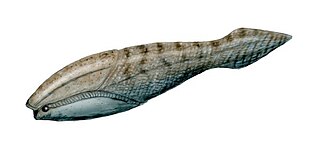
Arandaspida is a taxon of very early, jawless prehistoric fish which lived during the Ordovician period. Arandaspids represent the oldest known craniates, a proposed group of chordates that contain all chordates with a cartilage-derived skull, and hagfish. The group represents a subclass within the class Pteraspidomorphi, and contains only one order, the Arandaspidiformes. The oldest known genus of this group is Sacabambaspis found in South America.

Bothriolepis was a widespread, abundant and diverse genus of antiarch placoderms that lived during the Middle to Late Devonian period of the Paleozoic Era. Historically, Bothriolepis resided in an array of paleo-environments spread across every paleocontinent, including near shore marine and freshwater settings. Most species of Bothriolepis were characterized as relatively small, benthic, freshwater detritivores, averaging around 30 centimetres (12 in) in length. However, the largest species, B. rex, had an estimated bodylength of 170 centimetres (67 in). Although expansive with over 60 species found worldwide, comparatively Bothriolepis is not unusually more diverse than most modern bottom dwelling species around today.
Ichthyology uses several terms that are unique to the science.

Drepanaspis is an extinct genus of primitive jawless fish from Early Devonian marine strata of Europe. D. gemuendenensis, of the Hunsrück lagerstätte is the best known, and most thoroughly studied species, as it is known from several articulated specimens.

The Japanese bullhead shark is a species of bullhead shark in the family Heterodontidae found in the northwestern Pacific Ocean off the coasts of Japan, Korea, and China. This benthic shark occurs at depths of 6–37 m (20–121 ft) over rocky bottoms or kelp beds. Measuring up to 1.2 m (3.9 ft) long, it can be identified by its short, blunt head, two high dorsal fins with anterior spines, and pattern of irregularly shaped, vertical brown bands and stripes. The Japanese bullhead shark is a docile, slow-swimming species that feeds mainly on shelled invertebrates and small bony fishes. Reproduction is oviparous, with females laying spiral-flanged eggs in communal "nests". This species is of little interest to fisheries.
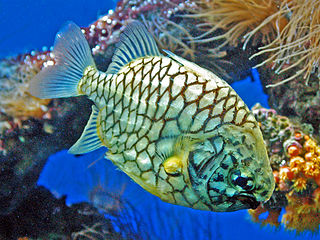
The pineapplefish is a species of fish in the family Monocentridae, and the sole member of its genus. It is also known as the knightfish or the coat-of-mail fish, due to the armor-like scales covering its body, and the port-and-starboard light fish, as it has a pair of bioluminescent organs that are reminiscent of navigation lights on ships. Its specific epithet is from the Latin gloria and maris, meaning "glory of the sea".

Pteraspidiformes is an extinct order of heterostracan agnathan vertebrates known from extensive fossil remains primarily from Early Devonian strata of Europe and North America, and from Upper Silurian Canada.
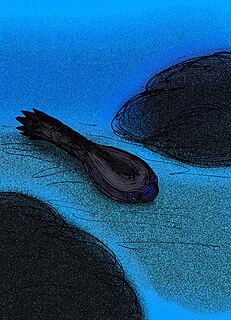
Cyathaspidiformes is an extinct order of heterostracan vertebrates known from extensive fossil remains primarily from Silurian to Early Devonian strata of Europe, and North America, and from Early Devonian marine strata of Siberia.

Amphiaspidida is a taxon of extinct cyathaspidid heterostracan agnathans whose fossils are restricted to Lower Devonian marine strata of Siberia near the Taimyr Peninsula. Some authorities treat it as a suborder of Cyathaspidiformes, while others treat it as an order in its own right as "Amphiaspidiformes." In life, they are thought to be benthic animals that lived most of their lives mostly buried in the sediment of a series of hypersaline lagoons. Amphiaspids are easily distinguished from other heterostracans in that all of the plates of the cephalothorax armor are fused into a single, muff-like unit, so that the forebody of the living animal would have looked like a potpie or a hot waterbottle with a pair of small, or degenerated eyes sometimes flanked by preorbital openings, a pair of branchial openings for exhaling, and a simple, slit-like, or tube-like mouth.

Amphiaspidoidei is a taxon of extinct amphiaspidid heterostracan agnathans whose fossils are restricted to Lower Devonian marine strata of Siberia near the Taimyr Peninsula. In life, the amphiaspidids of Amphiaspidoidei are thought to be benthic animals that lived most of their lives mostly buried in the sediment of a series of hypersaline lagoons. Amphiaspids are easily distinguished from other heterostracans in that all of the plates of the cephalothorax armor are fused into a single, muff-like unit, so that the forebody of the living animal would have looked like a potpie or a hot waterbottle with a pair of small, or degenerated eyes flanked by preorbital openings, a pair of branchial openings for exhaling, and a simple, slit-like mouth.
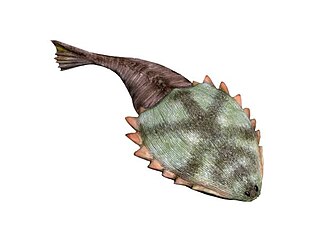
Hibernaspidoidei is a taxon of extinct amphiaspidid heterostracan agnathans whose fossils are restricted to Lower Devonian marine strata of Siberia near the Taimyr Peninsula. In life, hibernaspid amphiaspidids are thought to be benthic animals that lived most of their lives mostly buried in the sediment of a series of hypersaline lagoons. All amphiaspids are easily distinguished from other heterostracans in that all of the plates of the cephalothorax armor are fused into a single, muff-like unit, so that the forebody of the living animal would have looked like a potpie or a hot waterbottle with a pair of small, or degenerated eyes, a pair of branchial openings for exhaling, and, in the case of hibernaspids, a simple, slit-like mouth at the anterior end of a tube-like head.
Siberaspidoidei is a taxon of extinct amphiaspidid heterostracan agnathans whose fossils are restricted to Lower Devonian marine strata of Siberia near the Taimyr Peninsula. In life, siberaspids are thought to be benthic animals that lived most of their lives mostly buried in the sediment of a series of hypersaline lagoons. As with all amphiaspids, siberiaspids are easily distinguished from other heterostracans in that all of the plates of the cephalothorax armor are fused into a single, muff-like unit, so that the forebody of the living animal would have looked like a flattened potpie or a hot waterbottle with a pair of small, or degenerated eyes sometimes flanked by preorbital openings, a pair of branchial openings for exhaling, and a simple, slit-like, or tube-like mouth.

Amphiaspididae is a family of extinct amphiaspidid heterostracan agnathans whose fossils are restricted to Lower Devonian marine strata of Siberia near the Taimyr Peninsula. In life, the amphiaspidids of Amphiaspididae are thought to be benthic animals that lived most of their lives mostly buried in the sediment of a series of hypersaline lagoons. Amphiaspids are easily distinguished from other heterostracans in that all of the plates of the cephalothorax armor are fused into a single, muff-like unit, so that the forebody of the living animal would have looked like a potpie with a pair of small, or degenerated eyes, with each flanked by a preorbital opening, and a simple, slit-like mouth.

Amphiaspis argo is the type species of the cyathaspidid taxon Amphiaspidida, and of the family Amphiaspididae. Its fossils are restricted to early Emsian-aged marine strata of the Taimyr Peninsula, Early Devonian Siberia. A. argo, as with all other amphiaspidids, is thought to have been a benthic filter feeder that lived on top of, or buried just below the surface of the substrate of hypersaline lagoon-bottoms.

Amphoraspis stellata is an amphiaspidid heterostracan in the family Amphiaspididae. Its fossils are restricted to early Devonian-aged marine strata of the Taimyr Peninsula, Siberia. A. stellata, as with all other amphiaspidids, is thought to have been a benthic filter feeder that lived on top of, or buried just below the surface of the substrate of hypersaline lagoon-bottoms.
Edaphaspis bystrowi is an extinct amphiaspidid cyathaspidid heterostracan. Its fossils are restricted to early Devonian-aged marine strata of the Taimyr Peninsula, Early Devonian Siberia. E. bystrowi, as with all other amphiaspidids, is thought to have been a benthic filter feeder that lived on top of, or buried just below the surface of the substrate of hypersaline lagoon-bottoms. It is the only representative of the family Edaphaspididae.
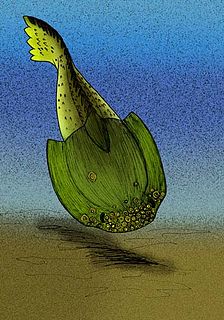
Gabreyaspididae is a family of extinct amphiaspidid heterostracan agnathans whose fossils are restricted to Lower Devonian marine strata of Siberia near the Taimyr Peninsula. In life, all amphiaspidids are thought to be benthic animals that lived most of their lives mostly buried in the sediment of a series of hypersaline lagoons. Amphiaspids are easily distinguished from other heterostracans in that all of the plates of the cephalothoracic armor are fused into a single, muff-like unit, so that the forebody of the living animal would have looked, in the case of gabreyaspidids, vaguely like a horseshoe crab with a pair of small, or degenerated eyes, with each flanked by a preorbital opening, and a simple, slit-like mouth positioned slightly ventrally.

Hibernaspis is a genus of extinct amphiaspidid heterostracan agnathans whose fossils are restricted to Lower Devonian marine strata of Siberia near the Taimyr Peninsula. In life, species of Hibernaspis were thought to be benthic animals that lived most of their lives mostly buried in the sediment of a series of hypersaline lagoons. All amphiaspids are easily distinguished from other heterostracans in that all of the plates of the cephalothorax armor are fused into a single, muff-like unit, so that, in the case of Hibernaspis, the forebody of the living animal would have looked like a large guitar pic with serrated edges, with a pair of tiny, degenerated eyes, a pair of branchial openings for exhaling, and a simple, slit-like mouth at the anterior end.
Eglonaspididae is a family of extinct amphiaspidid heterostracan agnathans whose fossils are restricted to Lower Devonian marine strata of Siberia near the Taimyr Peninsula. In life, all of the amphiaspidids are thought to be benthic animals that lived most of their lives mostly buried in the sediment of a series of hypersaline lagoons. Amphiaspids are easily distinguished from other heterostracans in that all of the plates of the cephalothoracic armor are fused into a single, muff-like unit, so that the forebody of the living animal would have looked, in the case of elgonaspidids, very much like a hot water bottle with or without a pair of small, degenerated eyes and a simple, slit-like mouth positioned at the anteriormost portion of the cephalothoracic armor.

Sphaerosyllis levantina is a species belonging to the phylum Annelida, a group known as the segmented worms. It was first described from Haifa Bay in the eastern Mediterranean. It is similar to Sphaerosyllis hystrix, and is thought to show a cosmopolitan distribution. Its name derives from its type locality, levantina being the feminine form of a neo-Latin adjective meaning "pertaining to the region where the sun raises"; the adjective is feminine to agree with the feminine genus name, Syllis being a river nymph in Greek mythology.












